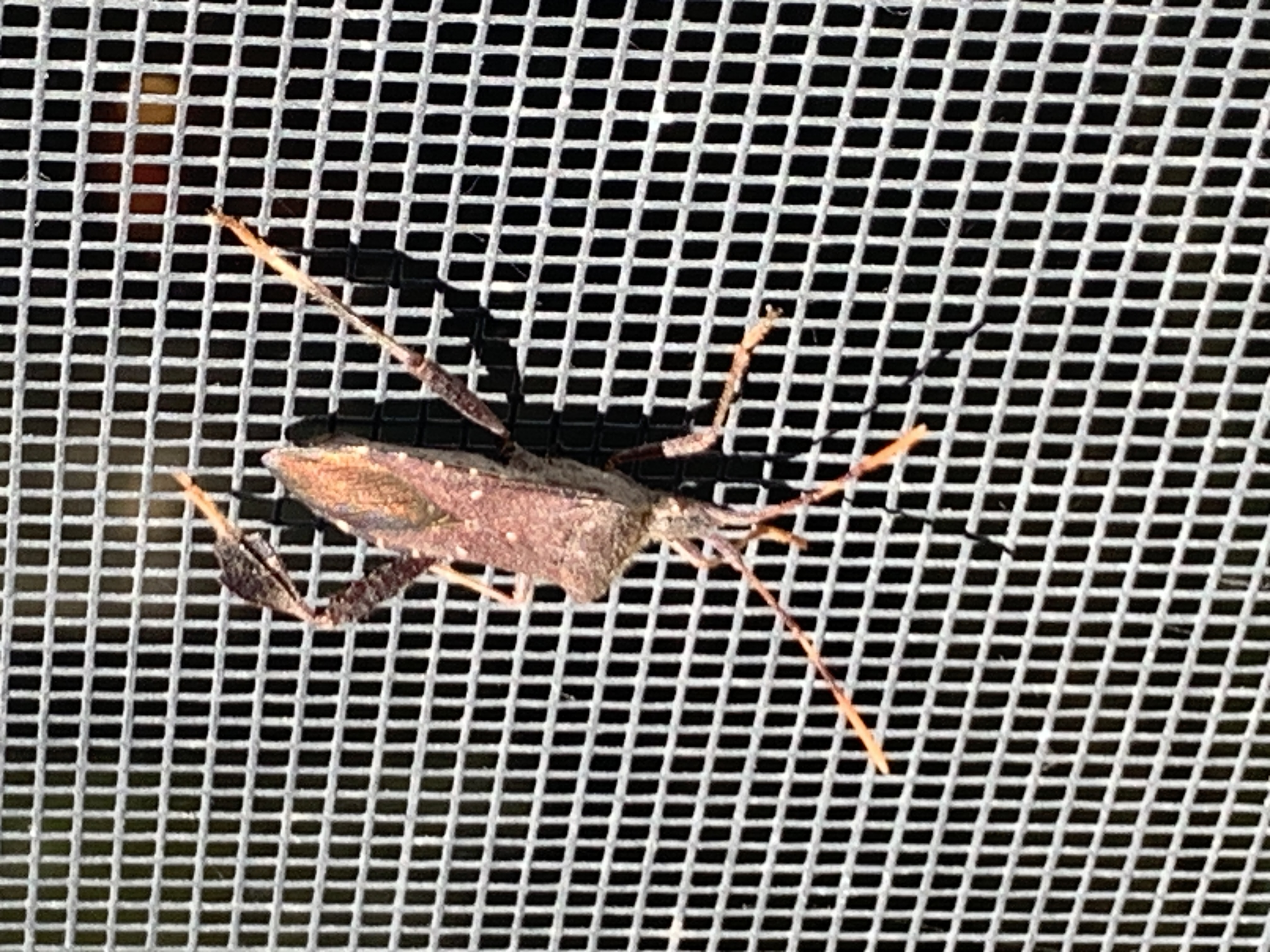In the late fall, all manner of insects are planning to spend the winter on Owl Acres. They are congregating and searching for sheltered places to survive the snow and wind and the drop in temperatures. Asian lady beetles swarm out of the fields where they had been eating aphids. They line themselves up on the posts on my deck. Some make their smelly way into the house and hang on the ceiling. Marmorated stinkbugs find their way past the screen into the windowsill. Boxelder bugs join the rush. Another sort of insect is also out there hunting for warm places. It’s known as a northern leaf-footed bug (Leptoglossus opositus). It’s another true bug, characterized by its plant-juice sucking mouthparts.
This brown insect with reddish-brown compound eyes and two segmented antennae on its elongated head is not a beauty queen. Its face sports piercing-sucking mouthparts, including a sharp, needle-like organ it uses to poke a hole in a leaf or stem and suck out the juices. Its thorax, the segment behind its head, supports six legs and two pairs of wings. The forewings are half leathery and half membranous, and aren’t used for flying. They protect the fragile membranous hindwings when the bug is at rest. The hindwings are all membranous and that’s what they fly with. The loud buzzing and flight patterns they create when they fly are reminiscent of, and often confused with, bees. Five crisscrossed black patches on the abdomen are visible when they take flight. Leaf-footed bugs can also excrete a stinky substance when they’re threatened.
The main defining feature, though, is the hind legs. The lower segment is flattened side to side, and enlarged with scalloped edges protruding front and back. Viewed from the side, this part of the leg looks like a small, dry, oblong leaf; thus the name leaf-footed. The males also have serrated teeth on the inner surface of the upper leg. Males use these features on their hindmost legs to fight other males over females.
This native species is one of about 90 leaf-footed bug species found in North America. It is distinguished by three white dots forming a triangle on its back. Many cousins of our northern leaf-footed bug are named for and matched with a specific plant, such as the milkweed bug, the sweet potato bug or the squash bug. Our northern leaf-footed bugs are not particular and will eat pretty much anything. They are especially fond of catalpa, but like to stick their little needles into seeds and fruits of all kinds. When they do, they damage the seed or the fruit. They may also introduce a fungal yeast that disfigures the fruit.
Female northern leaf-footed bugs lay their eggs in the spring on the undersides of leaves. The eggs are usually laid end to end in long strings. When they hatch, orange nymphs emerge, looking like the adults they will become except that they don’t have any wings yet. They do have their little needle suckers, and will start in on the nearby leaves immediately. Over the next 30 days or so they will go through five instars, getting bigger with each one. Finally they reach their adult size Of one-half to three-quarters inch long. They’ll also have their wings and their dark brown coloring. They’ll harden off their exoskeleton in preparation for foraging and mating, and get to the business of eating.
Leaf-footed bugs overwinter as adults. They look for sheltered places to congregate like wood piles, and will come into the house if they can. They will emerge in late spring and lay eggs. By late summer they are out and about, drinking the juice from tomatoes, watermelon, squash and other garden plants. They also like citrus fruits, seeds and nuts. They can eat pecans and pasticcios by softening them up first with digestive enzymes.
Frogs, toads, mantises, geckos and similarly sized predators will eat the nymphs. Adults make tasty snacks for larger predators such as birds, rodents, beetles, and reptiles.
We’ll continue to see bugs, including the leaf-footed ones, soaking up rays on a cool afternoon, but the first hard frost will be the end of those still out and about.
Photo by Author. Alt text: An insect with angular body, tiny head and two antennae sits head-down on a window screen in the autumn sunshine. Leaf footed bug has flattened, leaf-shaped expansions on its hind legs, which give the animal its name.
